June/July 2008
You Meet the Nicest People in...
Colombia!
aka: Pavimiento – Mas o Menos...
Topes, vibradors, tumulos, and now, resaltos; they’re all bumps
in the road -- there are plenty of them -- and they are plenty big.
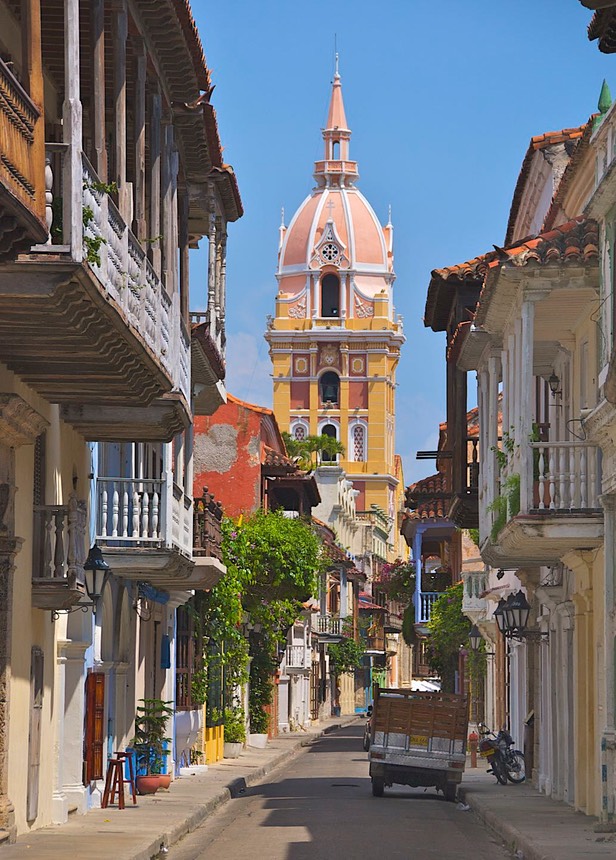
We are very excited to be able to tell you that our Colombian adventures have been absolutely wonderful. All told, we have spent almost two months in this beautiful country, and have enjoyed it tremendously. We have never met more gracious, delightful people, always courteous and anxious to help. Colombia gets a bad rap in the United States and Europe because of its past. But if you would like to enjoy stunning countryside and hospitable people – and in a safe environment – come see for yourself. You won’t be disappointed. Where else can you walk into a business office and be offered coffee; if you walk into an auto repair place you will also be offered coffee; someone shows up to try and help dig you out of the hole you’ve dug yourself into (stay tuned!), and he brings you fresh coffee; how great is that?
As you may remember, we started out in Cartagena. We arrived on a Sunday, hoping to pick up La Tortuga on Monday. Unfortunately, Monday was a holiday in Cartagena; they were celebrating the 475th anniversary of the founding of the city. So we spent our time wandering around taking pictures and appreciating this old colonial town. Cartagena is a walled city, as are many old port towns. We were reminded of Campeche, Mexico, whose walls were also built as protection from pirate attacks. The walls are still standing, along with a cool fort and castle on a hill. But we mostly just wandered from street to street, as most people do, taking pictures of the incredibly lovely architecture, with balconies filled with lovely flowers overhanging the streets.
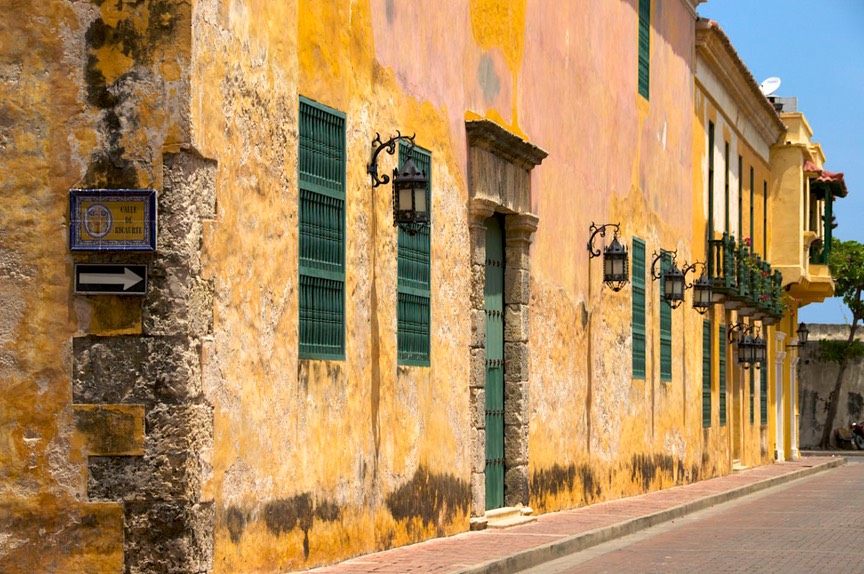
Until we reclaimed La Tortuga, we were staying in a lovely, small, very European hotel with great air conditioning (it was really HOT), that had a central courtyard filled with birds and even a monkey named Pili. Totally cool. We took our breakfasts alongside the critters, and fed them bits of papaya. Not too shabby.
After we finally got our rig out of hock, and cleaned out and ready for travel, our last chore was to find some automotive insurance. Other travelers said they hadn’t bothered, and had been all right, but we knew Colombian law requires liability coverage. We thought we should try and get it before leaving town. We started by asking for help at the hotel, and they sent us to a big insurance agency downtown. The people there were lovely, and although they couldn’t write us a policy, spent a long time helping us out. We had our first experience with Colombian hospitality. Cannot help, but please have a cup of coffee while we work on the problem for you. An hour later, we had the name of an agency down the street that could take care of us. And they did; for $41 US we had a policy in hand that should satisfy our needs. So off we went into the countryside, clueless but happy to be on our way.
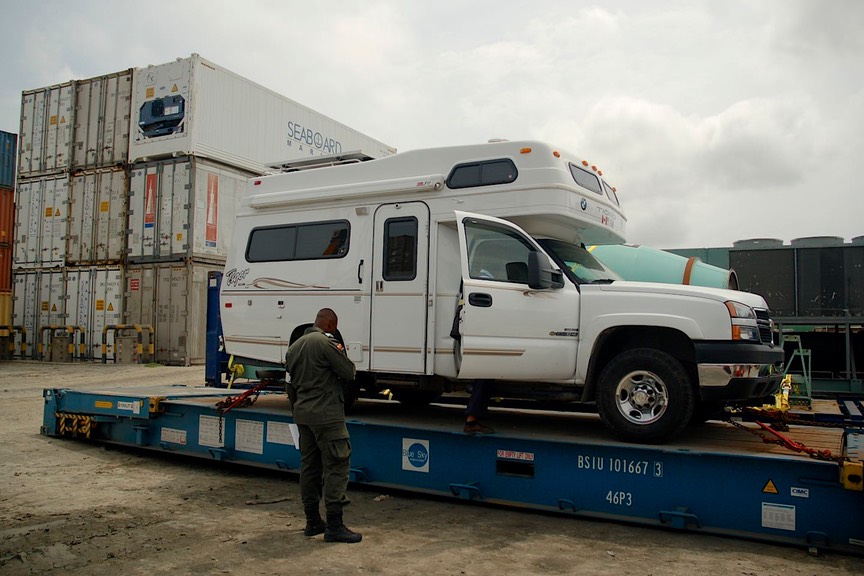
And within 30 miles we had to show those documents twice. Other uberlanders (that’s what we’re called, we’ve just found out!) had been luckier; we were glad we hadn’t taken the chance. We were on the road between Cartagena and Medellin, and maybe this area is patrolled more strictly. The soldiers were very businesslike and demanding. They even made Rick get out of the car at one point, and they kinda patted him down. But to date, this is the only stretch of road where we were treated this way. Otherwise, we’ve mostly been waved by; if stopped they are just interested in us and curious. And very polite. They refer to our rig as “casa de los gringos.” We have been delighted to find a continuation of the same friendly attitude we experienced in Mexico and Central America.
Well, we spent the next two days trying to get off the coast and up into the highlands, where we could get cool. As in all the tropical countries we have visited, the lowlands seem poor, with agriculture but not much else. The cattle were scrawny; so were the burros carrying firewood. We immediately noticed there were many more motorbikes than cars and trucks on the roads. This had been true in Cartagena, but we assumed that was because of the tiny streets in the old town. Not so; it has been true everywhere in this country. We also are seeing tons of old jeeps where we used to see pickups; they are used for everything – as taxis and small trucks, as well as the more normal passenger vehicle. Also evident are hordes of well maintained and shiny old American trucks, not pickups, but heavy duty rigs of all brands from the fifties and sixties.
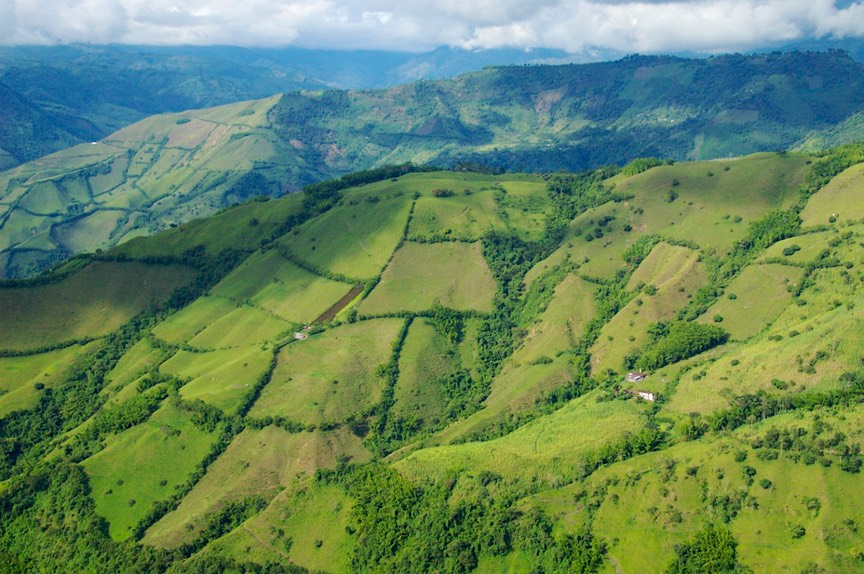
None too soon, the second night out of Cartagena we were up in the mountains; we spent the night along a narrow mountain road, high in the mists. There was much water running off the slopes and often we were dodging large chunks of missing road. A slalom trail. The third night we were right up there, at 8400 feet; for the first time in months we turned on the heater in the morning. Absolute heaven! We went past several pretty little towns clinging to the slopes; the church spires should have been hooks to help keep them in place. In Colombia, for the first time, many of the houses were made of brick; the rich red color is very attractive.
This mountain road we were traveling is the main road between Cartagena-Medellin-Cali and down into Ecuador. Very, very busy, with huge trucks moving big loads. The truckers do stop at night; a cottage industry has sprung up with truck stops that include rudimentary hotels next to large parking lots and small open-air restaurants. The truckers often keep going late into the evening, but eventually they quit and all is quiet until daylight, when the road becomes very crowded again. The water running off the hillsides is channeled, by drainage, into hoses that spout into the air, wherever there is a wide spot in the road. The truckers will take a break and wash their rigs. It’s quite a sight.
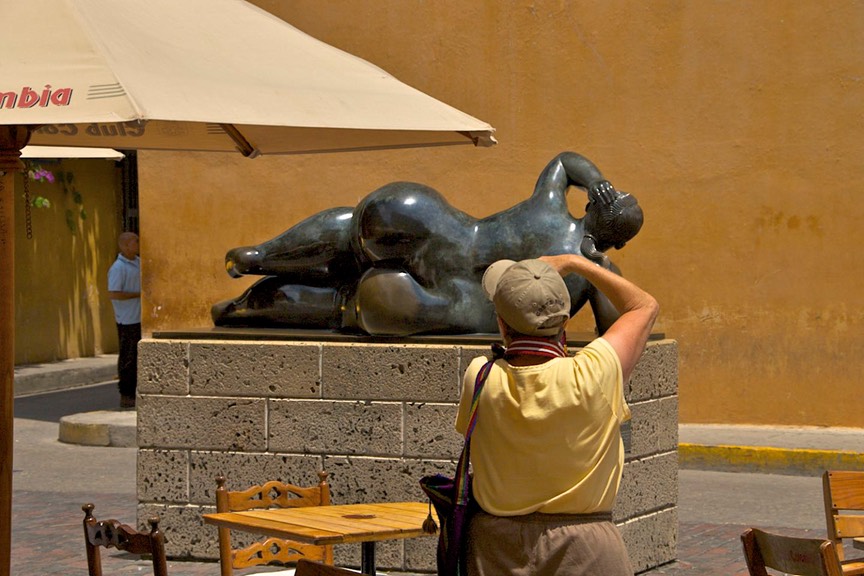
Medellin was our destination. We spent three days there, in part to enjoy the city, and in part to have the Chevy dealer look at a truck problem. We’d had a check engine light showing for a couple of months, but there are no American car dealers in Central America, just Japanese, Korean and Chinese makes. But we had seen online that things would be different in South America; in Colombia, for example, Chevrolet is the number one seller. We stopped in at a Chevy Truck dealer; they said they weren’t the right place for our vehicle, but sent us on to a car dealer nearby, even giving us the name of a fellow there who spoke English. They took us right in, let us stay overnight in the shop, then diagnosed the problem and let Rick use their phone to order the parts from the states. Then we were on our way, with plans to return in a few weeks to have the work done. The folks were wonderful to us; and in talking to Juan, our English speaker, it turned out that his mother is American and attended Cal Poly in San Luis Obispo, where Juan has visited. How small is our world?
We also detoured to a clinic to look at an earache Kathy had acquired. This was a very good experience, we are happy to report. Scolded by the doctor for waiting so long, she had a thorough examination (with no waiting) and several prescriptions filled, all for a total cost of 52,500 pesos -- about $30.00. Try and beat that!
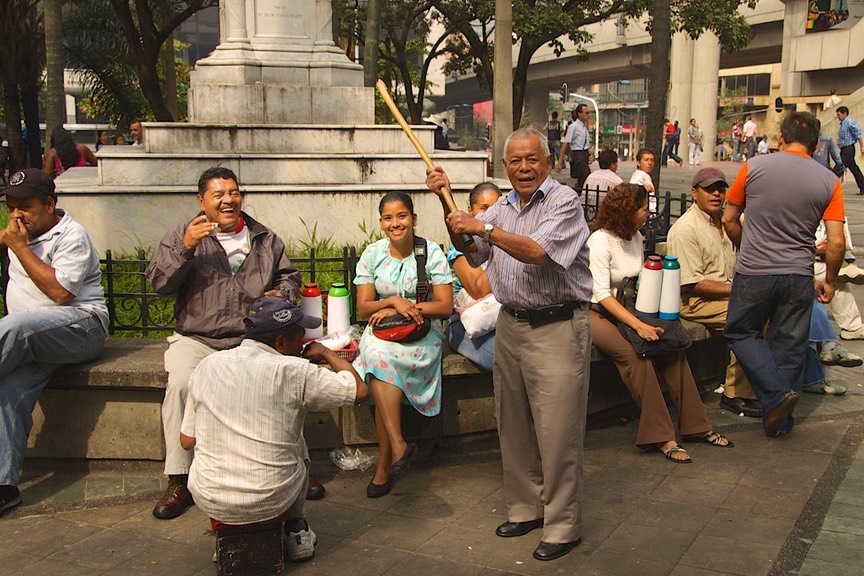
Medellin is pretty difficult to drive in; as we are finding in Colombia in general the maps aren’t worth much, and city maps are pretty bad too. Despite there being decent (read: some) signage, the streets don’t go where they should, they are all one-way the wrong way, the traffic is awful, and well……you can guess the rest. But after several days, we got the hang of it and could get pretty much where we want to go – if the road isn’t closed. Diesel fuel is running about $3.40/gallon, with regular unleaded a little over $4.00.
All that aside, we loved Medellin. It is a beautiful modern city, clean and filled with trees; the parks have neat statuary (Fernando Botero was born here and is very well represented); there are lots of nifty old buildings in good shape; and you can get there on a lovely modern Metro rail system. We prowled around and had a good time. Nary a sign of a drug lord anywhere.
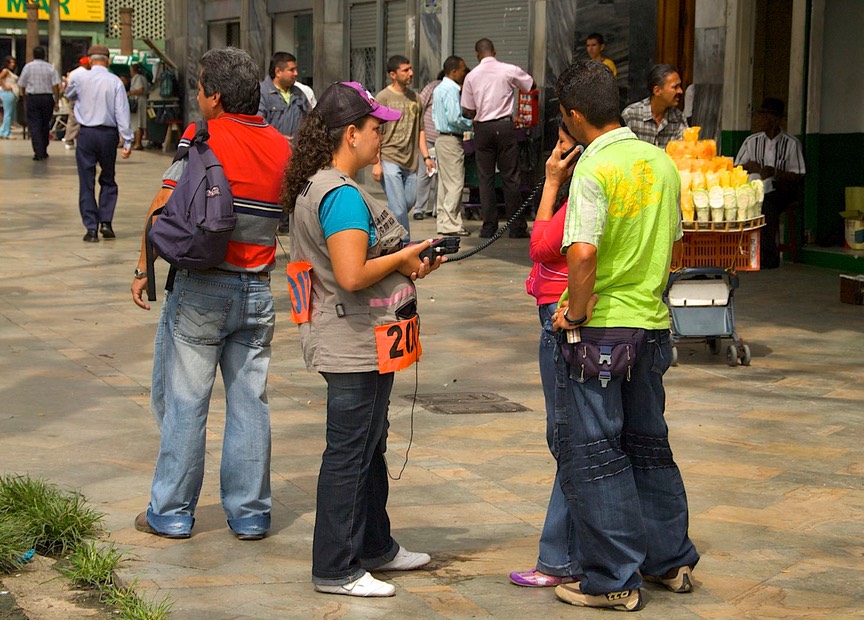
For the first time, in the downtown area, we saw people standing on the street corners who WERE THE TELEPHONES. We’ve repeatedly seen signs talking about minutes for sale; we’d assumed the vendors were selling chips for your phone. But here, people would be standing in the middle of the plaza with lines dangling from them. Someone would come up and rent a phone for a few minutes, make their call, pay, and leave. How cool is that! And to show you how modern the city is, there is at least one shopping center (the Mayorga) which has the entire complex wired for wi-fi. We loved it.
We also saw tiny little motorbike parking garages (parqueadoros) tucked away between high downtown buildings; evidence of just how many of these bikes are scrambling around on the streets. They are everywhere. We got caught in a hailstorm one afternoon; as you would go through an underpass, the bikes would be so thick with people waiting out the weather that you could hardly get through – and this on the autopista!
Medellin is remarkably free from air pollution for a city of over a million that sits in a bowl between mountain passes. When the sun was out the views were stunning. We really enjoyed our time there and were not unhappy we needed to come back in a few weeks to have repairs done.
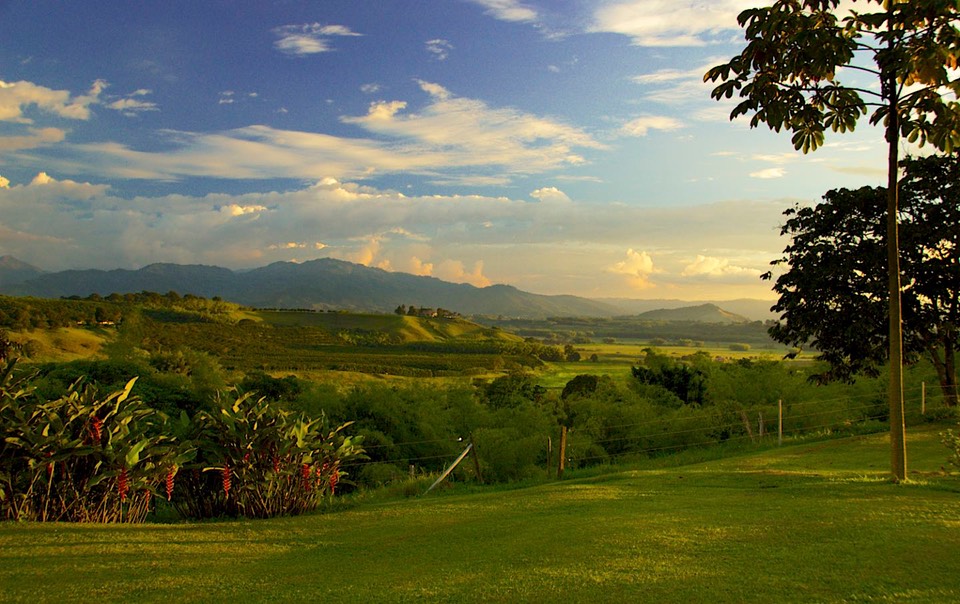
But in the meantime we headed further south, to make our way down to the coffee-growing region that is supposed to be so very lovely. By the end of the first day we were thoroughly confused, as we had followed the map as we knew it. Fat lot of good that did! But we found ourselves in a small, lovely town, Supia, staring at a large gap between where our road abruptly stopped, and where it began again, on the far side of a bridge that was washed-out in a storm eight days earlier. “You can’t get there from here.” So, we spent the night at the fire station, backtracked to where a road did cross the river (a huge rushing thing, not surprising it had taken out the bridge), found the road we were supposed to be on, and trekked onward. The valleys were filled with fields of sugar cane, then as we climbed a bit, citrus and avocadoes. And then into the coffee – Colombian coffee – the real thing.
We had been told about a place near Armenia called Hacienda Bambusa. It is a hotel built by a former uberlander, and he welcomes travelers such as ourselves; we can stay as long as we want. The hotel is wonderful and the setting absolutely gorgeous; it is deep in the middle of a banana finca, with a cattle ranch here also, and stunning views of the valley we sit on the edge of (oops, bad grammar again).
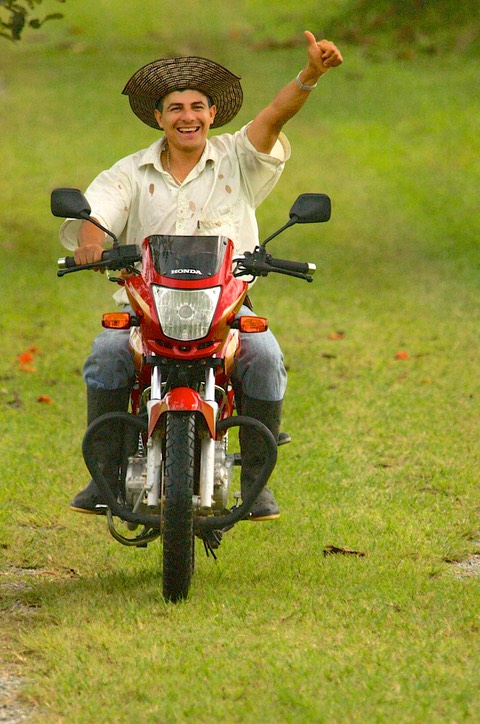
For you race car enthusiasts, the owner’s father is Diego Montoya, who raced internationally in sports cars in the 80’s; including Le Mans and Sebring and winning the IMSA race at Laguna Seca one year. His nephew is Juan Pablo Montoya, who won the Indy 500 awhile ago, is a past CART champion, raced Formula I in Europe for four years and is now very busy with NASCAR racing with the Chip Ganassi team.
Anyway, this was the most beautiful place we’d been in quite awhile and we settled in for some rest, computer time, and catching up on projects around the coach. We were adopted by two of the workers on the property, brothers in their 20’s, both of whom invited us into their homes for late afternoon coffee. The birds were plentiful (“Yellow bird, high up in banana tree”), the cattle, this Brahma-cross we find so enchanting, the hotel was quiet and has a lovely pool (and good food), the washing machine on site made all our things clean again, there were walks and pictures to be taken. Heaven, complete with afternoon thundershowers (we’ve been told that we are having an La Nina year and it is wetter than usual; so be it). We were very happy.
Well, after almost two weeks at the Hacienda Bambusa we finally pried ourselves out of our parking spot and moved on. We had seriously considered just taking up permanent residence, but realized that just wouldn’t be right. So, after a final day, which included a lovely lunch with Diego and his wife, we packed up and started back toward Medellin. We had gotten a message saying that our replacement part had arrived from the United States, and so we made an appointment to have the work done, leaving several days in between to do some sightseeing.
Working our way back to Medellin was just great. We found small roads over mountain passes and through beautiful countryside – coffee, sugar cane, cattle, citrus – fertile and green. Our earlier experiences in the States had given us a history of thinking of “fields” as being relatively level ground. Not here. “Field” is very vertical in Colombia; the slopes are steep and not overly stable; the crops are there anyway.
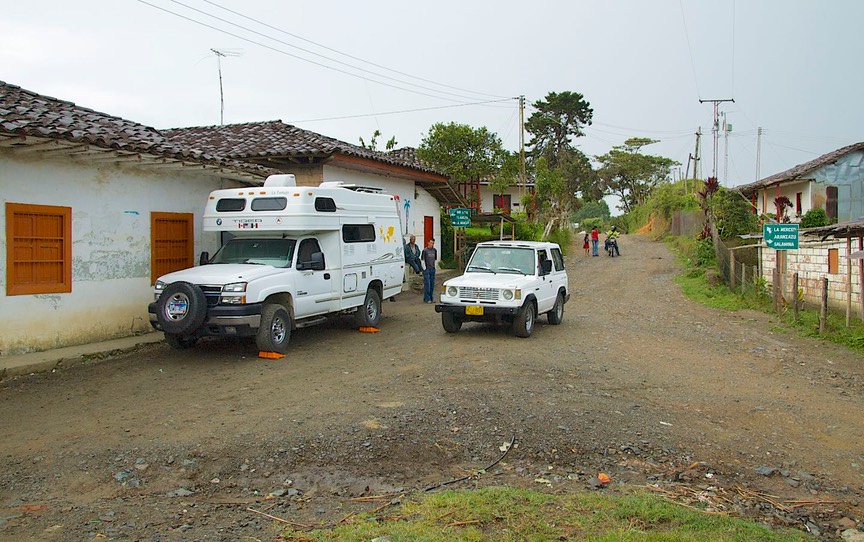
And “not overly stable” is an understatement. Everywhere in Colombia we have repeatedly encountered torrents of water coming off the hills, parts of the road washed away, bridges out, slumps in the road, etc. Colombia also gets earthquakes, of course; the countryside is often marked with signs saying the area is geologically unstable. Adds to the merriment.
We meandered through little towns clinging to the hillsides. Rick the Intrepid would see something he thought looked interesting in a town we were passing (usually a church spire), and off he’d go, careening straight up the first street he saw that headed toward the town center. It was just like being in San Francisco. Just as steep; just as scary; but we sure got into some interesting places.
We spent one quiet night in front of the only little grocery in a tiny hamlet. Seems like the entire town came by to say hello at one point or another. After we’d been there for about an hour, a man and his daughter came by and insisted we join them for dinner. Seems they had a fish pond in the back yard; they caught fish for us and then cooked and served it to us. And the family sat and watched while we ate it. We felt as conspicuous as hell, but what were we to do? Actually, it was a delightful experience, just one more example of how friendly and hospitable all Colombians appear to be. (Another day, we had stopped beside the road to have lunch, and a local approached us to chat. He was very apologetic, as he really wanted to invite us home with him, but right there he only had land, no house. Amazing people.)
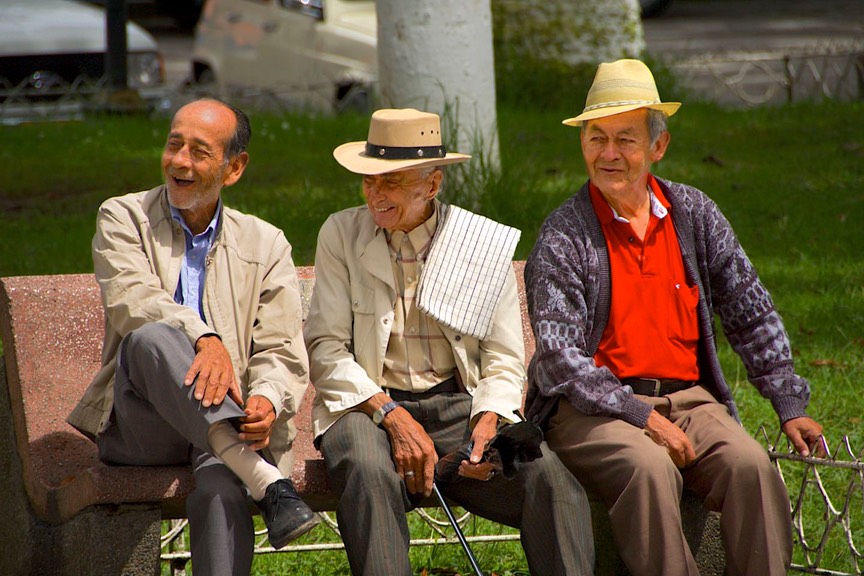
We have felt safe in Colombia. Their current president has been in office about five years and has made tremendous progress in taking the country back from the guerrillas as well as in cleaning up the cities and the countryside. We find Colombia to be probably the cleanest of the Latin American countries we have visited so far. There is a large police presence on all the roads, making us feel good; but also we ask about safety as we go along. We are staying in relatively developed areas, and aren’t checking out the high, remote areas. In talking to Diego Montoya, he commented that the guerrillas are in the highest mountains and most remote valleys – the most beautiful areas, he said. We’ll take a pass! Also, while the roads do need a lot of work, and the poor stability of the ground is constantly evident, there is also much evidence of road work underway and recently completed improvements. We are told that the president enjoys approval ratings of over 80%, and it is obvious that all Colombians seem to be very proud of their country and eager for us to enjoy it and to tell others about it.
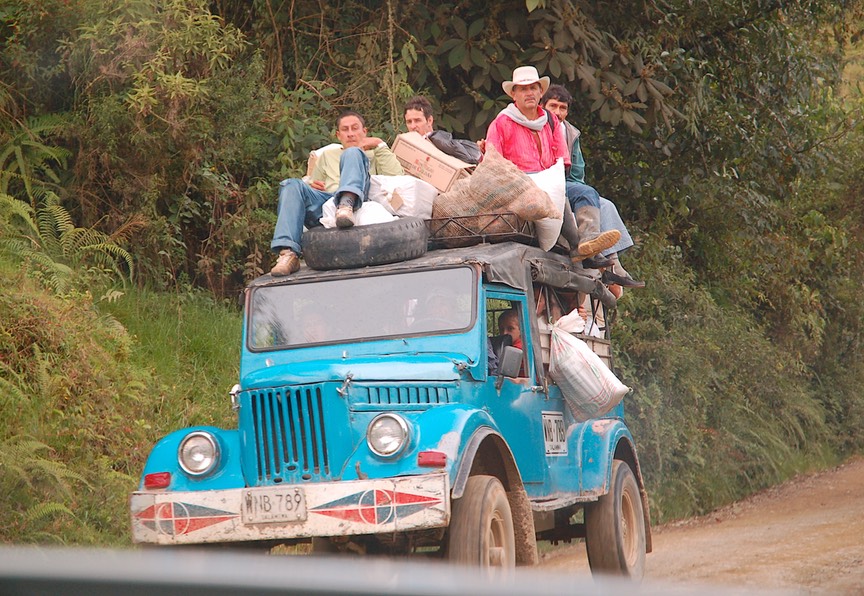
Many of the little towns we are visiting are preparing for fiestas at the end of this month. It is the feast of Sts. Peter and Paul, and the last weekend of June is a national holiday. In Salamina, in chatting with a man who was creating new concrete steps for the gazebo on the square, as soon as he discovered we were from America, he started saying “Orlando” over and over. It seems he had been there and it was his way of establishing a relationship with us. This has happened over and over. They all want to know how we like Colombia, where we are from and where we are going.
A curious thing to us was that even in the most remote areas everyone had electricity. Taking a walk after dark, there would be lights on all over the valleys; we thought we were pretty remote, but there were folks everywhere!
We’ve mentioned that motorbikes are the way so many people travel down here. The drivers are licensed and wear helmets and vests, both with their license numbers on them. Most often they have a passenger, often with a second, matching vest and helmet. These are quite apparently a form of taxi. You will see women passengers wearing all sorts of get-ups; the other day we spotted a lady on the back and we were entranced by her choice of fetching strappy high heels to accompany her jeans; in her arms were packages and a small child.
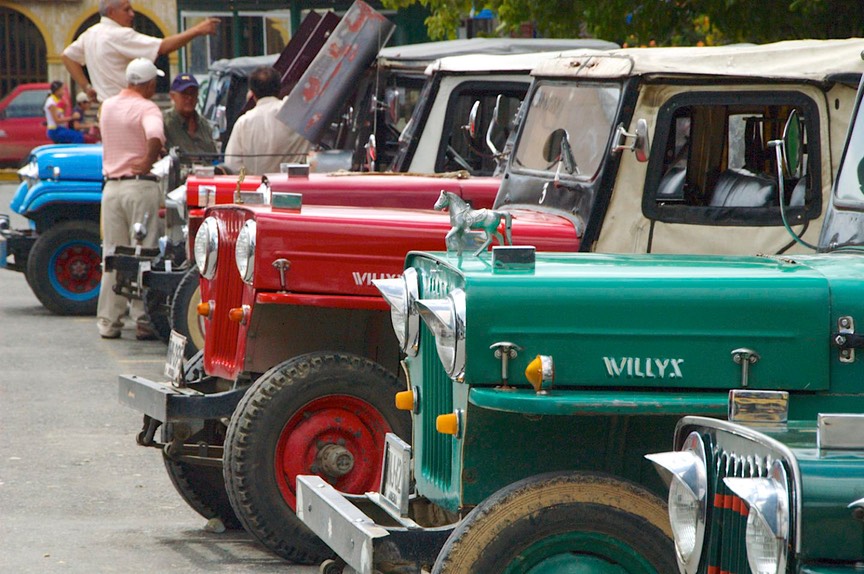
In addition to the motorbikes, of course, in Colombia, more than any other country we’ve see so far, they use all of these marvelous old vehicles. American trucks form the 50’s and 60’s, Jeep timeless old French Renaults, and trucks like this one that we never did identify. All of them are painted, waxed and shined to within an inch of their lives, and seem to run pretty well too. It’s neat!
Traveling, you go up over a mountain and then down the other side, cross a large river, and repeat – all day. These roads are pretty slow going, due both to the number of slides and the amount of lost pavement, but also to the enormous amount of truck traffic. As far as we can see, every item that is shipped into the north is trucked to the south – to Bogata, to Medellin, to Cali. And those trucks aren’t all beautiful and new, either.
Taking a break one night, we stopped at a balneario (swimming resort) that had camping in La Pintada, along the very large Rio Cauca. La Pintada is a resort town and they were gearing up for the fiestas coming that weekend. Double decked party buses with bands on the top level, lots of music, plenty of campers, it was fun. But still being the middle of the week, it all quieted down at night and we slept soundly.
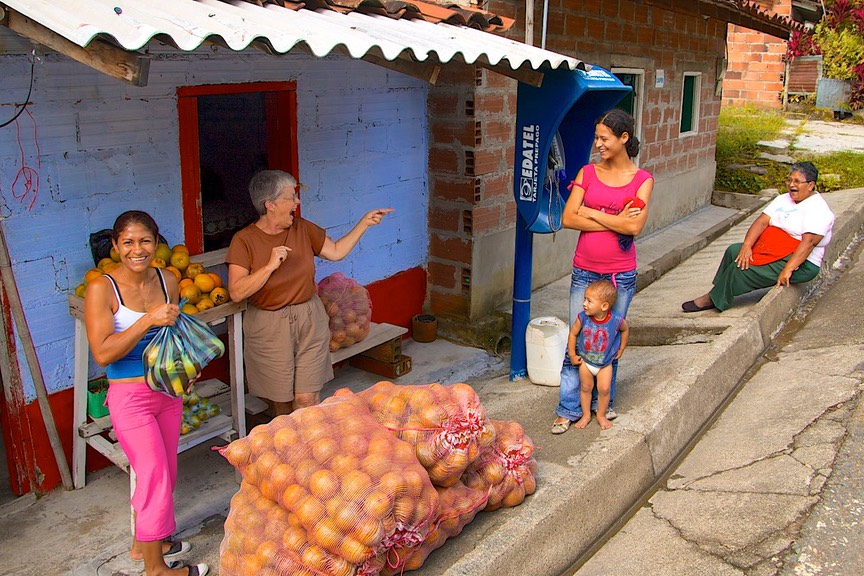
We wanted to visit a few of the well known little towns in the mountains southwest of Medellin. And we were on the perfect road: no trucks, little traffic, lovely views; of course it was unstable and we did our usual slalom run, but we were delighted.
In Tamesia, the local motorcycle taxi guys adopted us and spent a long time asking us questions about where we’d been and where we were going and checking out the map on the side of the coach. This map has proven to be one of the best investments we ever made. It is a map of the world, in continents, and we have drawn on it our route starting with our summer in Alaska last year. It draws lots of attention, and everyone enjoys talking about the various places. We’ve added flags for each country we have visited and people always seem pleased to see theirs up there.
In leaving Tamesia, we asked for directions to Jericho; each time, the person questioned frowned, looked at our vehicle, and then pointed us on. We soon understood why. As you leave the nicely paved town of Tamesia, the nicely paved road turns into -- a cow path. Almost literally. We both grinned and groaned, but gamely went forward. It was quite a ride. Probably 20 miles, taking us probably 2-1/2 hours. But splendid countryside; worth every second.
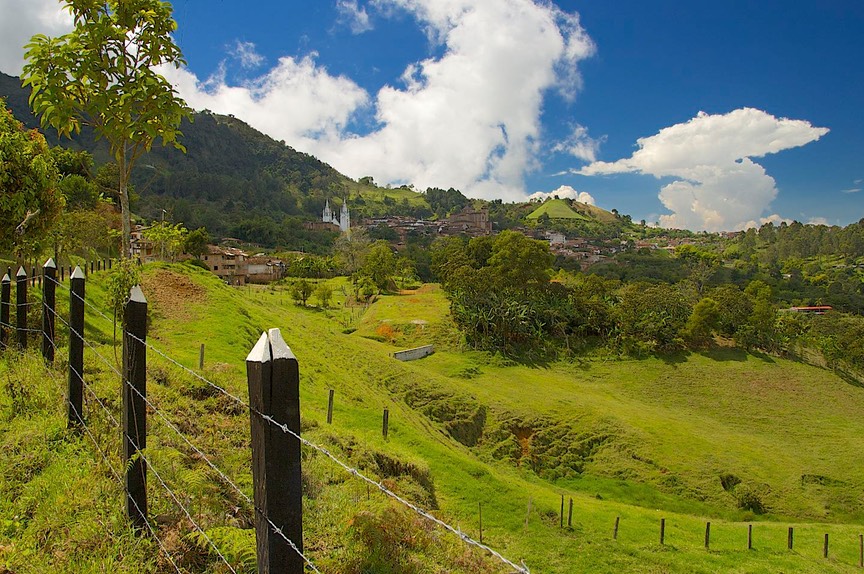
In Jericho (probably our favorite of the towns south of Medellin) we had a delightful older man, Gustavo, stop us, chat for awhile, and then take us to his home on the square. Jericho is an historic colonial town, and his home had been built in the 1890s, he had been born there (along with his 10 children); it was quite lovely, with high ceilings, excellent views over the square, and beautiful furnishings, most of which he had himself grown up with. It was two-story, built around an open courtyard. We were overwhelmed. After we finished our tour, he insisted on buying us coffee so we could chat further. We love Colombia!
Before arriving back in Medellin we made a short stop in Santa Fe de Antioquoia, probably the best-known colonial city in the area. We were quite disappointed, possibly because we had just left Jericho and Tamesia, but also the whole town center was all “tarted up” with ugly stalls, wires everywhere, dirty people, etc. all getting ready for the busy holiday weekend.
We quickly moved on, back to Medellin, and fortunately checked in with the Chevy dealer. He said they would be closed on Monday, for the holiday (which had been our intended repair date), but they could do the work tomorrow (Saturday) if we’d like. Would we like? Yes, yes, yes! When done we could get on with our plans to see the rest of Colombia.
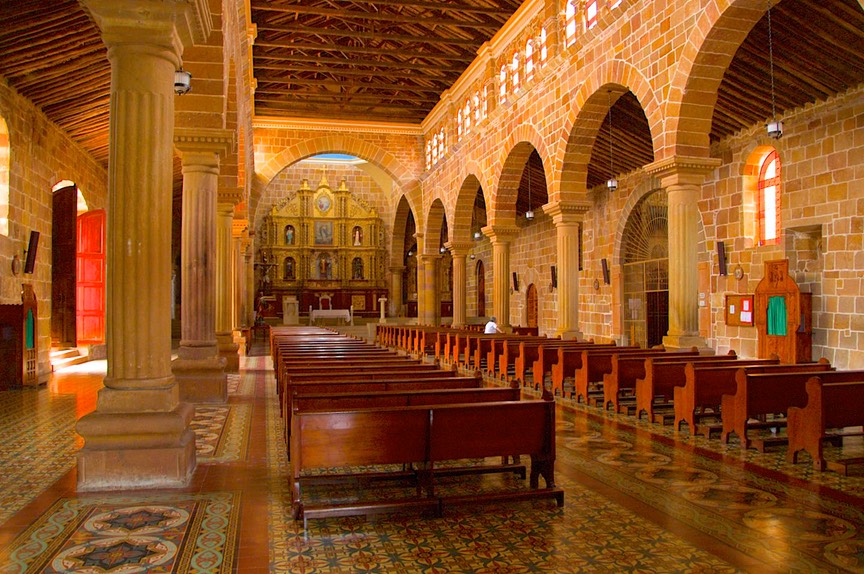
The work was done quickly, efficiently, well, and very inexpensively ($40 labor covered both of our visits!). And we were gone from Medellin for the last time, by 10:00 am. Free as a couple of birds. Now, just a holiday weekend to dodge, and life would settle down.
And now a new direction. We went east from Medellin through the mountains (lovely), then dropped all the way down to the mighty Rio Magdalena (flows north to the Caribbean), and then further east to join the main highway in Bucaramanga. We were back in the lowlands now, and getting hot again, and anxious to keep going south to Bogota, but we had a few towns to the northeast that had been recommended: Giron, San Gil, and Barichara.
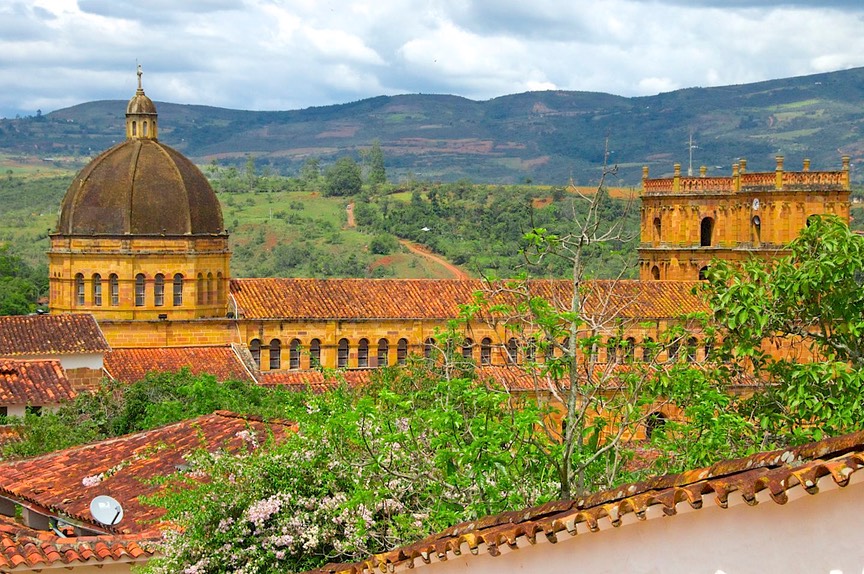
We visited each; some were a bit disappointing, but Barichara is a jewel. It is a town that has not been allowed to develop past its colonial beginnings in the 1700s; it is very small and was quiet on this, the day after the 3-day weekend. We were delighted with the small square, the lovely cathedral, and most of all, the local dirt, which is a rich caramel color and is used in constructing the buildings. We took tons of pictures! An interesting sidelight: this is a tobacco-producing area, the first we had seen since Nicaragua.
Moving on, south now, towards Bogota, we started climbing into the mountains again (hurray!). We turned off the main road, hoping to find a way through the mountains that wouldn’t involve the terrible traffic we were experiencing on the highway, the major road between the Caribbean coast and Bogota. We found a wide spot to stop for lunch; very peaceful – for about 3 minutes. A soldier approached us; it was his regular post, he was happy to have us stop for an hour or so, and spent the whole time singing (very good voice, but he was wafting patriotic songs over the hillsides), right next to the coach because then he could stand under the shade of the awning. After awhile he was joined by 3-4 friends; they were cute, but they made enough commotion that we decided to move on. Shortly thereafter our good road turned to really bad road and we knew we had about 60 miles to go; so we turned around. This road fit our definition of NP-NLA-NSOs (no pens, no lipstick application, no holding sharp objects.)
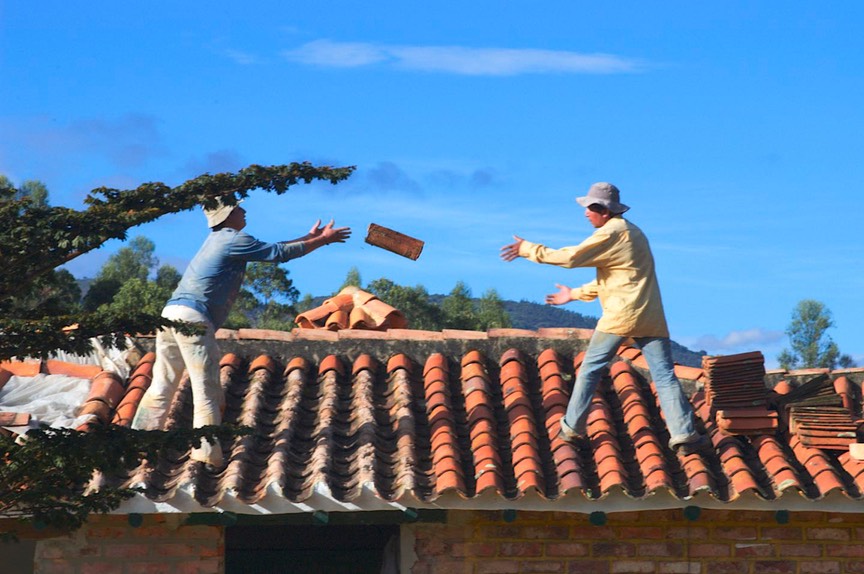
Back on the main highway we trudged on. It started getting dark and we were getting concerned about a safe place for the night. Finally, we stopped at a roadside restaurant that had some level parking, and Rick went in to ask the manager. They said okay, but seemed kind of confused. We settled in, but very soon someone pulled up behind us and unloaded a pig into a chute to get weighed (we obviously hadn’t taken a good look at our surroundings). Rick got out and had fun with the pig guys, the restaurant people came out to get involved and the children nearby got a good look at our coach. We were feeling pretty good, but the restaurant owner came over and said we really wouldn’t be safe here. His home was a short ways away; would we be willing to come park at his house, behind a secure gate? Now how nice was that! He was gracious and nice. We had a quiet night. We were feeling guilty about not eating at the restaurant, but I was working my way through a nasty cold and not fit company for anyone – and it was an open-air restaurant and it was raining cats and dogs. So we passed. I’m sure they understood.
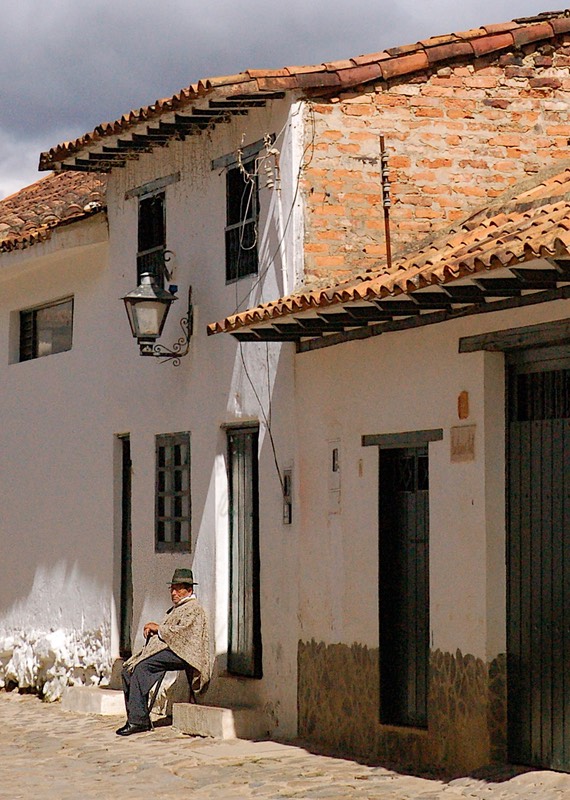
The next morning we were off to Tunja (pronounced like the fish, but with a hiccup in the middle). We came to a road division and all the trucks went to the right while we went to the left. We were delighted; we drove through a lovely green valley which took us over 10,300 feet (still corn growing – but stunted) to Arcabuco and then to Tunja. We were finding this area stuningly gorgeous, very fertile, filed with dairy cattle and multiple crops in the rich soil, even this high up. Also lots of greenhouses. For the first time we saw both men and women wearing ponchos and those dark men’s hats you see in all the pictures. In Tunja we wanted to see the old town center. But this city is toooo big and toooo narrow. After a policeman stopped us, scowling, we put our tails between our legs and beat feet out of town. We made plans to visit later, although they never came to pass. Tunja will just have to wait.
A few miles outside Tunja (still at 10,000 feet) you drop 700 meters (you figure it out) into an open valley and the pretty national monument town of Ville de Leyva. It’s lovely, very traditional, but with enough tourists to have good restaurants and shopping. We camped in a camping area outside of town and enjoyed ourselves for several days, as we geared up for the national capital. In visiting the local sites, including a lovely monastery garden, we noticed that some of the flowers were blooming at strange times, including poinsettias -- and it was now early July.
Ah, Bogota. What to say? We approached the city with trepidation. We just don’t go into big cities if we can help it. And we might well have skipped Bogota entirely, if we hadn’t had a couple of contacts, people who were offering a spot to park. We were able to stay north of the city, follow our host into the metropolitan area as he led us to a place where we could park for the day. and take a taxi into the old part of the city. And it worked out pretty well.
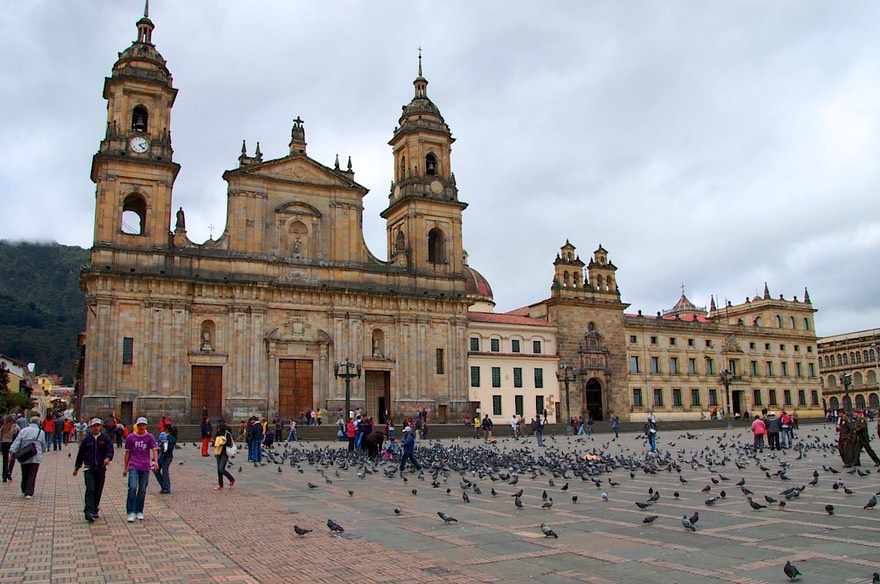
Bogota is over 8,000 feet; you are reminded of this as you hike around from one old colonial site to the next. Fortunately, they are mostly in a relatively small area. There are nice buildings, good museums, the national government offices (we had a nice tour with a soldier who seemed quite willing to take us places he probably shouldn’t have -- he kept peering around to see who was nearby), and more Fernando Botero statues and paintings. He’s cool. The new part of Bogota is to the north, and very new it is; cropland is being replaced by futbol fields and academies, housing developments, and horse arenas. The future of Colombia!
After a couple of days, we took off again, heading west and south. We wanted to see some more of the countryside, and also head back to Hacienda Bambusa for a few more days, and to pick up mail, before moving on south into Ecuador. We figured we could take in National Park Los Nevadas along the way. When we asked about this park, we were told it was fine, interesting, okay; whatever. Well....it was more than that for us. Moving along, we went over range after range of mountains, each lovely and a pleasure to drive through. We stopped for the night because we were climbing higher and higher into a cloud forest, and couldn’t see our noses ahead of us because of the fog.
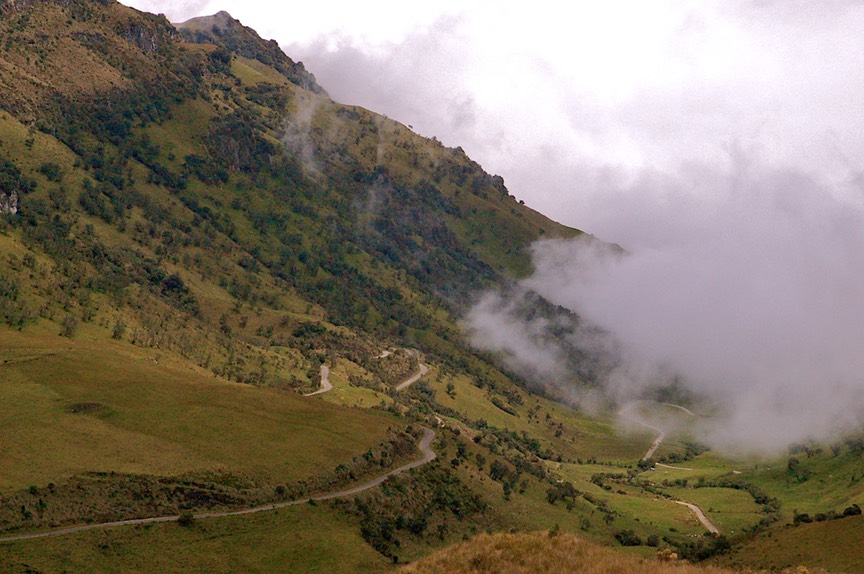
The next morning was clear and bright, and we were delighted, as we figured it would be a great day in the national park. We made the turn, the road was paved, the views were incredible. We climbed higher, into the clouds; we even saw snow on a pass off in the distance. Topped out at 13,800 feet. The road got bumpy. We came to a choice; we took the paved choice (which was the one we had been looking for), heading down a road that was even on Rick’s GPS. We were cool. We started dropping; past small dairy farms and pastures. Pavement ended. Dropping into fog. Misty and gorgeous. Very damp; ferns (12,200 feet!) and beautiful wildflowers, even lupine and a yellow broom. Damper. Very wet. Very isolated. Road getting quite sloppy. And then.....oops. We dropped into a mudhole; stuck. Damn!
Well, this could be a very long story as we were stuck in the mud for more than 24 hours, but we’ll try to just give you the short version which is a true Good News, Bad News tale.
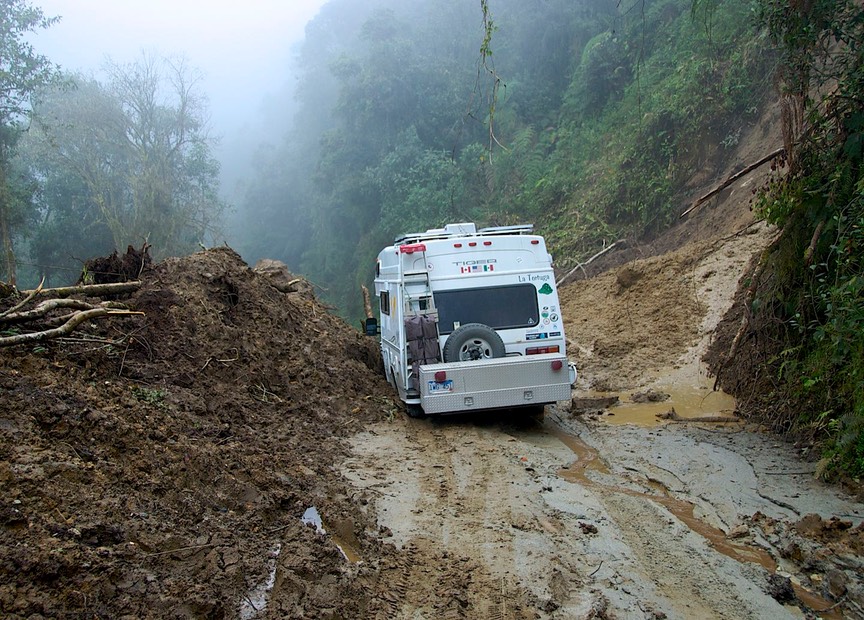
The mud hole was the result of a landslide covering the road, then being dug out to allow passage, but continuing rainy weather kept the landslide active and continued to feed the already wet and sloppy conditions. I (this is Rick telling the story at this point) didn’t think it looked all that bad, but it turned out to be plenty bad enough. We barely got into it when the truck just stopped moving. Well, along came a fellow on a bicycle who tried to contact a tow truck for us and then just started digging along with a local fellow who responded to our request for help. The two of them worked all afternoon as it got colder and colder, with Christian, the bicyclist, not leaving us until after dark with assurances he would return in the morning with more help. We spent the night, at 10,300 feet and down to a low of 47 degrees, listening to the occasional sliding of mud down the hill toward us, but fortunately it did not rain.
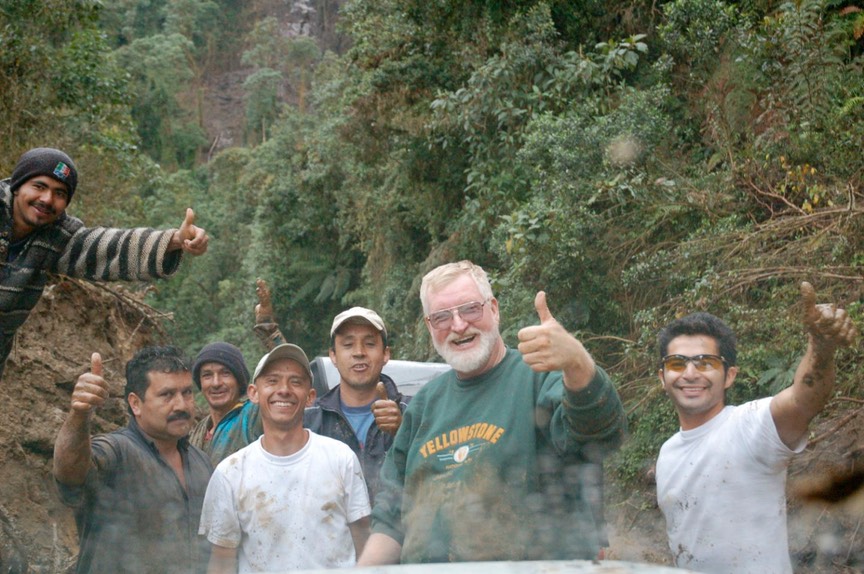
About 7:30 in the morning a fellow comes up on a motorcycle. He lived nearby and had been contacted by Christian to show up early so we would know we were not alone. He offered us coffee from his thermos and immediately got to work. After awhile a truck came along on the other side of the muddy section and three fellows got out. Two of them walked on after a bit, but the driver of the truck started working alongside the first fellow. At about 11:00 Christian arrived with two other fellows and a rented ’59 Jeep, and the farmer from the day before also arrived. So there were now six Colombian fellows giving up their Saturday to work tirelessly in ankle deep mud and occasional rain to try to dig us out. It was really touch and go and there were times I despaired of us getting out without a much bigger vehicle to assist us - especially after one of the truck’s tire stems broke and the tire went flat - but the guys were great, joking and laughing and all pitching in just unbelievably.
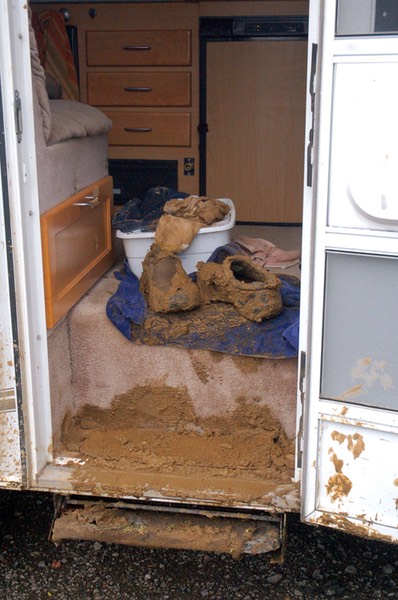
Finally, about 3:00 we managed to get a little movement from La Tortuga and with the Jeep pulling and all the guys rocking and pushing we got ourselves out of the hole and down the road. Everyone Laughed and Cheered and posed for group photos of “El Gringo Stupido and Los Colombianos Locos”. I was literally weak with relief and happiness.
Well, if that wasn’t enough of a story, Christian and his two friends from town, Gustavo and Mauricio (Chi-Chi) guided us down the hill the 18kms to town, insisted on paying for lunch for all of us despite our original offer to treat them; took us to a tire shop to repair the tire; stopped by Gustavo’s mother’s flower shop for flowers for Kathy; and finally, after much hugging and exchanging of e-mail addresses, left us at about 5:00 pm to go on our way. None of these three fellows would accept any payment, ‘though we did give money to the others who had helped. Christian simply said that no payment was needed, tapping his chest he repeatedly said “Mi Corazon” and “nuevo amigos”.
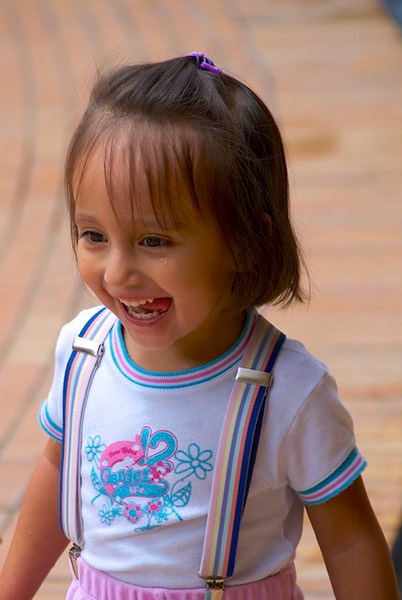
This experience tops all of our other encounters with the wonderful Colombian people; and while I still wish I hadn’t driven into that mud, the memory of those guys and their cheerful willingness to help total strangers will be with us always.
After all of these experiences, and finally getting back to Bambusa, we decided it was time to send you this message. We figured (1) nothing could top this last story, (2) we thought you might be getting worried because you hadn’t heard from us in forever and we were in Colombia, for god’s sake, and (3) our sixty day visas expire soon so from here we will head straight on down the Pan American Highway into Ecuador, with only a couple of stops and we’ll tell you about them later! So here it is. We are cleaning up the coach, and ourselves, getting a little R&R under the trees, and will proceed on in a few days. Should be simple; should be no problems; we’ll see! Obviously we are undaunted (but perhaps a little more cautious about asking for information before starting down strange roads with no vehicles coming at us! And a whole lot more cautious about driving into muddy places in the road) and still having a wonderful time. Wish you were here to help keep us out of trouble! Come join us, and, oh yeah… bring a shovel!
Oh, and whatever else you do... Someday, you must come to Colombia!
Kathy, Rick and the Mighty Mountain Tortoise! (Wait a minute, Tortoises don’t belong in the mountains… Oh, yes they do)
Click the link to see more photos from Colombia.